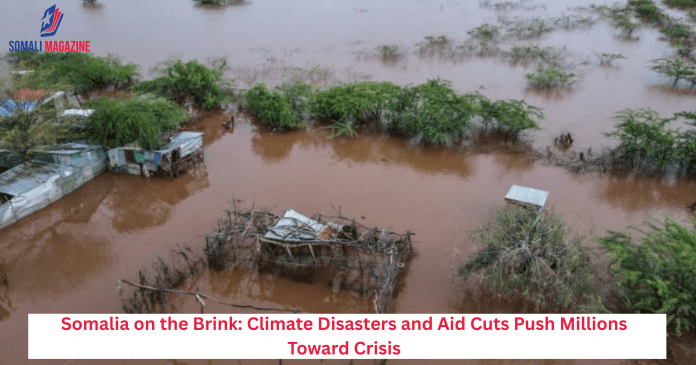Facebook Twitter (X) Instagram Somali Magazine - People's Magazine
As extreme weather and conflict worsen, shrinking global support leaves vulnerable communities struggling to survive
Mohamed Abdukadir Teesto, a 43-year-old resident of Mogadishu, is worried about his future. His home was recently damaged by heavy rains, and like many others, he received no help from the government or aid agencies. He had to clean the house with his bare hands. “Some families still can’t return because their homes are destroyed. If it rains again, we’ll face the same disaster,” he said.
Teesto is one of about 24,000 people affected by recent flooding in the Banadir region, which includes the capital, Mogadishu. The floods killed at least 17 people and displaced many more. These severe weather events are becoming more frequent in Somalia, a country already struggling with decades of conflict and instability.
The United Nations has named Somalia one of the countries most vulnerable to climate change. In the past five years alone, the country has faced extreme droughts and once-in-a-century flooding. These environmental shocks are making life even harder for Somalis, many of whom are already living in poverty and fear due to violence and political unrest.
The situation is getting worse as international support shrinks. Aid programs from the US Agency for International Development (USAID) have been cut, and the UN says it has only received 12 percent of the $1.4 billion needed to help Somalia this year.
“This can get very, very bad, very quickly,” warned Sara Cuevas Gallardo, spokesperson for the World Food Programme (WFP). The WFP, which provides about 90 percent of food aid in Somalia, is now unsure if it can meet rising needs due to the funding shortfall.
CARE International recently reported that 1.8 million Somali children under the age of five are severely malnourished. Of those, nearly half a million could die without immediate help. Gallardo fears Somalia may again face famine conditions, like those between 2020 and 2023, but this time with even fewer resources to respond.
Conflict is also a major factor. The International Crisis Group has warned that climate change can fuel violence, and Somalia is a clear example. Recent attacks by Al-Shabaab, an extremist group linked to Al-Qaeda, are adding to the problems. People already struggling with hunger and displacement now face renewed fears of violence.
Globally, conflict is the top cause of hunger, and in Somalia, it’s combined with climate disasters. “This means more people going hungry, more families on the move, and less ability for us to help,” Gallardo said.
Save the Children, another major aid group, also raised the alarm. The charity said it would have to shut down more than a quarter of its health and nutrition centers in Somalia due to funding issues. Every facility in Baidoa, a central city hit hard by drought and food shortages, is expected to close.
The group shared the story of Fatima, a 25-year-old mother who fled her village after drought ruined her crops and killed her animals. She and her one-year-old son now depend on aid to survive. “If we don’t get medicine and nutrition support, we’ll just have to watch our children die,” she said.
At a clinic in Baidoa, Dr. Mustafa Mohammed said the number of patients has already increased. If the clinic closes, there will be no other place for sick and hungry children to go. “We are at a breaking point,” he said.
With climate change, conflict, and funding cuts colliding, Somalia is facing a deepening crisis. Without urgent action and renewed international support, many more lives could be at risk.

